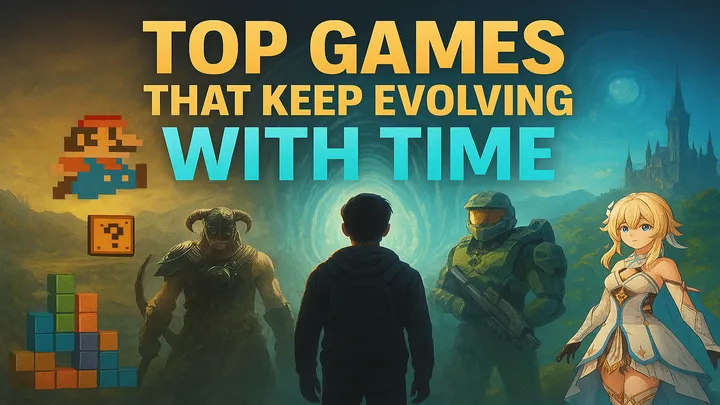The gaming industry has come a long way since its inception, with countless titles leaving a lasting impact on how we play today. Here’s a look at ten classic games that not only defined their genres but also shaped the future of gaming.
1. Pong (1972)
Overview
Pong is one of the earliest arcade games, simulating table tennis with simple graphics and mechanics. Players control paddles to hit a ball back and forth.
Key Features
- Simple yet addictive gameplay.
- Two-player competitive mode.
- Pioneering use of video graphics.
Why It Matters
Pong laid the groundwork for the gaming industry, introducing the concept of video games to the masses and sparking interest in arcade gaming.
2. Space Invaders (1978)
Overview
Space Invaders is a fixed shooter game where players control a laser cannon to shoot descending aliens. It became a cultural phenomenon in the late '70s.
Key Features
- Increasing difficulty as players progress.
- Iconic pixel art and sound effects.
- High-score tracking that encouraged competition.
Why It Matters
Space Invaders popularized the shooting genre and introduced concepts like high scores, which would become staples in gaming.
3. Pac-Man (1980)
Overview
Pac-Man is an iconic arcade game where players navigate a maze, eating pellets while avoiding ghosts. Its simple mechanics and charming character made it a hit.
Key Features
- Unique maze design with power-ups.
- Strategic gameplay requiring quick reflexes.
- Cultural icon status, spawning merchandise and adaptations.
Why It Matters
Pac-Man revolutionized arcade gaming and introduced characters and narratives into gameplay, paving the way for future storytelling in games.
4. Super Mario Bros. (1985)
Overview
Super Mario Bros. is a side-scrolling platformer that follows Mario on his quest to rescue Princess Peach from Bowser. It set the standard for platform games.
Key Features
- Innovative level design and power-ups.
- Engaging multiplayer and single-player modes.
- Memorable music and characters.
Why It Matters
Super Mario Bros. defined the platforming genre and established Nintendo as a leading force in gaming, influencing countless games that followed.
5. The Legend of Zelda (1986)
Overview
The Legend of Zelda introduced players to a vast open world filled with puzzles, dungeons, and exploration. Players control Link on his quest to rescue Princess Zelda.
Key Features
- Non-linear gameplay encouraging exploration.
- Complex puzzles and combat mechanics.
- Rich lore and immersive storytelling.
Why It Matters
Zelda set the standard for action-adventure games and introduced open-world mechanics, influencing many future titles in the genre.
6. Tetris (1984)
Overview
Tetris is a tile-matching puzzle game where players arrange falling blocks to clear lines. Its simplicity and challenge have made it a timeless classic.
Key Features
- Addictive gameplay with increasing difficulty.
- Simple controls and mechanics.
- Iconic music and visual design.
Why It Matters
Tetris popularized puzzle games and demonstrated the potential for video games to be both challenging and accessible to a wide audience.
7. Street Fighter II (1991)
Overview
Street Fighter II is a competitive fighting game that introduced special moves and combos, allowing players to choose from a diverse roster of characters.
Key Features
- Iconic character design and unique fighting styles.
- Multiplayer battles that fostered competition.
- Influence on the fighting game genre.
Why It Matters
Street Fighter II revolutionized fighting games, establishing competitive gaming and esports as a significant aspect of the industry.
8. Doom (1993)
Overview
Doom is a first-person shooter that set the stage for the genre, allowing players to navigate 3D environments while battling demons.
Key Features
- Pioneering use of 3D graphics and immersive gameplay.
- Modding community that extended the game's lifespan.
- Engaging multiplayer mode.
Why It Matters
Doom introduced first-person shooters to mainstream gaming and demonstrated the potential for immersive experiences in virtual worlds.
9. Final Fantasy VII (1997)
Overview
Final Fantasy VII is a role-playing game that follows Cloud Strife as he battles against the Shinra Corporation and Sephiroth. It’s known for its captivating story and characters.
Key Features
- Deep narrative with emotional themes.
- Expansive world and character development.
- Innovative turn-based combat system.
Why It Matters
Final Fantasy VII brought RPGs to a broader audience and set new storytelling standards in video games, influencing numerous titles in the genre.
10. The Sims (2000)
Overview
The Sims is a life simulation game that allows players to create and control virtual people and their households, simulating everyday life scenarios.
Key Features
- Open-ended gameplay with endless customization.
- Social interactions and relationships.
- Expansion packs that add content and variety.
Why It Matters
The Sims popularized simulation games and introduced a new way for players to engage with gaming, focusing on life and creativity rather than competition.
Conclusion
These classic games have left an indelible mark on the gaming industry, shaping the way we play and experience video games today. They not only paved the way for future innovations but also created a cultural legacy that continues to influence developers and players alike. Whether you’re revisiting these classics or discovering them for the first time, they remain essential parts of gaming history.

















